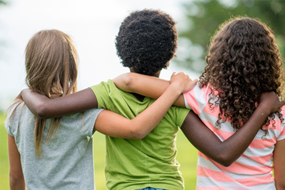#StopBullying

Bullying negatively impacts all youth involved—those who are bullied, those who bully others, and those who witness the bullying (bystanders).
Bullying is a type of youth violence defined as any unwanted aggressive behavior by another youth or group of youths who are not siblings or current dating partners; bullying involves an observed or perceived power imbalance and is often repeated multiple times or is highly likely to be repeated. Victims may experience harm or distress from physical (hitting, tripping), verbal (name calling, teasing), or relational/social (spreading rumors, leaving out of group) bullying. Bullying can happen in person and electronically (known as “cyberbullyingexternal icon”), at school or in other settings.
Bullying can result in physical injury, social and emotional distress, self-harm, and even death. It also increases the risk for depression, anxiety, and poor academic achievement. Youth who bully others are at increased risk for substance use and academic problems.
Bullying is widespread in the United States. Reports from the National Center for Education Statisticspdf iconexternal icon and CDC’s Youth Risk Behavior Surveillance System (YRBSS)pdf icon show:
- One in five high school students reported being bullied on school property in the last year.
- Nearly 14% of public schools report that bullying happens at least once a week.
- Reports of bullying are highest for middle schools (28%), followed by high schools (16%), combined schools (12%), and primary schools (9%).
- Reports of cyberbullying are highest for middle schools (33%), followed by high schools (30%), combined schools (20%), and primary schools (5%).
Not all children who are bullied show warning signs, but StopBullying.govexternal icon suggests being aware of these common signs:
- Unexplained injuries
- Lost or destroyed clothing, books, electronics, or jewelry
- Frequent headaches or stomachaches, feeling sick or faking illness
- Difficulty sleeping or frequent nightmares
- Declining grades, loss of interest in schoolwork, or not wanting to go to school
Parents, school staff, and other caring adults can play a role in bullying prevention.
- Help kids understand bullying.external icon Talk about what bullying is and how to stand up to it safely. Tell kids bullying is unacceptable. Make sure kids know how to get help.
- Keep the lines of communication open.external icon Check in with kids often. Listen to them. Know their friends, ask about school, and understand their concerns.
- Encourage kids to do what they love.external icon Special activities, interests, and hobbies can boost confidence, help kids make friends, and protect them from bullying.
- Model how to treat others.external icon Serve as role models by treating everyone with kindness and respect.
Research on bullying prevention continues to progress, and promising evidence is available for school-wide programs that can prevent bullying by strengthening youths’ relationship and problem-solving skills and modifying physical and social environments for youths’ protection.
Partner Resources… ¡en español!
CDC’s Youth Violence Prevention Technical Package, A Comprehensive Technical Package for the Prevention of Youth Violence and Associated Risk Behaviors includes a collection of strategies that represent the best available evidence to prevent or reduce youth violence.
Also available in Spanish. Un paquete técnico integral para la prevención de la violencia juvenil y los comportamientos de riesgo asociadospdf icon [3.89 MB]
Check out VetoViolence, CDC’s online source of free violence prevention training, tools, and resources.
- Be Someone’s Hero (available in English, and with Spanish captioning)
- StopBullying.govexternal icon – English website
- Espanol.StopBullying.govexternal icon– Spanish website
- CDC’s VetoViolence Facebook Page
